If you are a serious DIY enthusiast or just own a workshop then a best mini mill will definitely expand your productivity. But mini mills are not cheap. They can cost from hundreds to thousands of dollars. So, you are come up the right place. We’ll show you how to choose the right one.
To spare you the trouble of going through hours of research we did that for you and came up with a list of top 5 mini mills that you can buy today. If you don’t have the time to go through the whole review to can just go for our top pick the JET JMD-18 Phase Milling Machine. But we highly recommend you read our full guide before deciding.
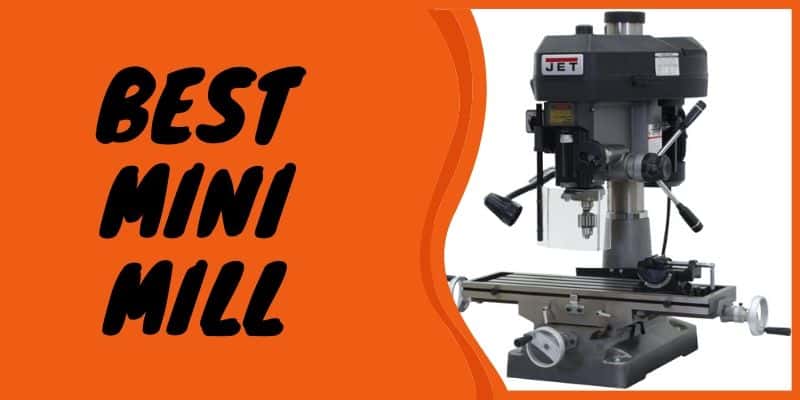
Quick Answer: Best Mini Mill for Gunsmithing
- JET JMD-18 Phase Milling Machine (Best Performance)
- Grizzly Industrial G8689 Mini Milling Machine
- Erie Tools EDT SM Best Benchtop Milling Machine
- Klutch Mini Milling Machine (Best Budget)
- SHOP FOX M1111 Mini Milling Machine
So, without further ado, let’s dive right into the review.
5 Best Mini Mills Reviews of 2026
1. JET JMD-18 Phase Milling Machine
If you are looking for the professional mini milling machine you could possibly buy for industrial use or personal use then look no further as the Jet JMD-18 vertical milling machine has everything that you could need and more.
The powerful 2 Horsepower motor allows you to reach a maximum spindle speed of 3,000 RPM. You can choose between 12-speed modes to ensure the right speed for the right job. The unit is also equipped with high end hinged belt cover to ensure fast speeding changing with minimum wait periods.
The table is pretty large measuring 9.5 x 31.75 inch allowing you all the freedom you could need while doing large scale projects. The Jet JMD-18 really shines when it comes to building quality. Especially the cast iron column provides extra durability and stability while drilling.
The price might seem a bit high. But powerful performance, great design, and durable construction make this the best mini mill for gunsmithing. So, if money is not a problem, we highly recommend this mini milling machine.
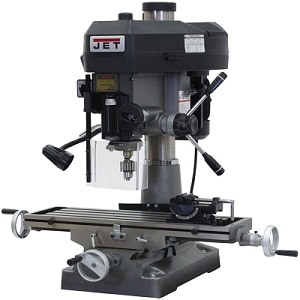
Specifications:
- Power: 2 Horse Power
- Voltage: 230 Volts
- Maximum speed: 3000 RPM
- Weight: 660 pounds
- Dimensions: 47x 40 x 51 inches
Features:
Powerful Motor: The Jet JMD 18 is a powerful milling machine that houses a 2 horsepower motor that is powerful enough to tackle almost any task you throw at it. If you are a hobbyist or a DYI enthusiast this should be more than enough. Even professional power users can use this milling machine for their workshops and crafts.
Durable Design: The jet JMD 18 shines when it comes to durability. The 2 year warranty it comes with reflects this. But we doubt you are ever going to need it as we have found this milling machine to be quite tough and built with quality components.
Minimum Vibration: The cast iron column and the overall heavy-duty build quality allows maximum shock absorption. So, you can expect accuracy and stability when using this unit.
High speed: With a maximum speed of 3,000 RPM you can make clean and accurate cuts with minimal jagging and tearing. But it does have multiple speed settings starting from 150 RPM that allows you to tune its performance to your needs.
Large table: The table is quite large for a jet milling machine allowing you a lot of space to work with. This flexibility is quite useful when taking on large scale projects.
Pros:
- Powerful motor
- Multiple speed settings
- Great maximum speed
- Astounding build quality
- Minimal vibration
- Great accuracy
- Large table size
- Easy to read dials
- Decent tramming
- 2 years warranty
- Included work lamp
Cons:
- Quite expensive
- Very heavy
- Very power-hungry
- Re-zeroing might be required for vertical moves
2. Grizzly Industrial G8689 Mini Milling Machine
The Grizzly industrial G8689 is a smaller and more lightweight option compared to the Jet JMD-18 for those looking for a more portable and compact option. Don’t get us wrong it is still pretty heavy. But as milling machines go it can be called portable.
Judging the size and weight of this machine is surely targeted toward the consumer category. Housing a 0.75 horsepower motor this is really not a slouch. The Jet JDM-18 can be a bit of an overkill for most users looking for a milling machine to keep in their garage. The Grizzly workbench perfectly fits for users looking to keep a mill in their garage.
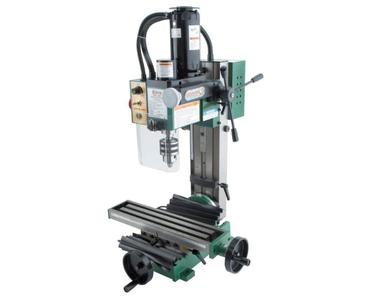
Specifications:
- Power: 75 Horse Power
- Voltage: 110 Volts
- Maximum speed: 2500 RPM
- Weight: 149 pounds
Features:
Compact: The machine is quite compact in size leaving a pretty small footprint in your workshop. Its offer cast iron table with 7/16 inches 3 T-slots.
Lightweight: The 149 lbs. this machine is super lightweight. Hobbyists and DIY enthusiasts can really appreciate the extra portability.
Variable speeds: With many speeds setting you can control its speed from 0 to 2500 RPM. This allows you full control over your work.
Minimal vibration: Having a cast iron built this milling machine is quite heavy-duty. Cast iron is also quite absorbent when it comes to vibrations. So, accuracy and stability are not a problem when using the Grizzly mini mill.
Pros:
- Decent motor
- Compact size
- Lightweight
- Variable speed setting
- 2500 RPM maximum speed
- Cast iron build
- Accurate and stable
- Minimal vibration
- Not very power-hungry
Cons:
- Not suitable for heavy use
3. Erie Tools EDT SM Best Benchtop Milling Machine
If you are looking for a best benchtop milling machine on a budget, we found the Erie tools EDT SM to be a great mini milling machine. It might not be as powerful as our previously mentioned mini milling machine but it surely does not cost as much. And we understand that not everyone can afford high-end devices.
The EDT SM mini milling machine is powerful enough for basic drilling and milling work. So, casual home users can find it quite useful. It is also light and compact. So, won’t take up much space which we understand would be a benefit for home users.
It has got some safety features like emergency shut off switch and clear spindle guard. But we did find the table to be on the smaller side making it not suitable for large projects.
Overall, it provides competent performance at a budget price. We would definitely recommend it if your wallet doesn’t stretch beyond its price point.
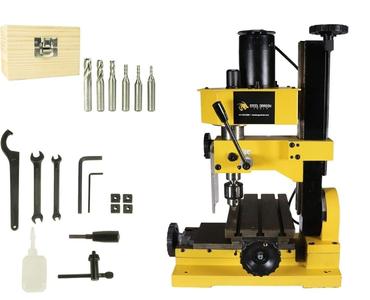
Specifications:
- Power: 2 Horse Power
- Voltage: 110 Volts
- Maximum speed: 2000 RPM
- Weight: 11 pounds
- Dimensions: 5 x 21.5 x 18 inches
Features:
Compact: The size and weight of the milling machine make it perfect for use in your home garage or a small workshop.
Safety features: For a low-cost milling machine it does come with a number of safety features. This includes a clear spindle guard and the emergency shut off switch.
High speed: This milling machine supports a maximum speed of 2000 RPM which we were kind of surprised by considering its price. Also, it supports variable speeds starting from zero which is kind of a must when we are talking about tools of this sort.
Pros:
- Decent power for home use
- Cheap price
- Compact size
- Lightweight
- 2000 RPM maximum speed
- Variable speed settings
- Safety features
- Comes with a good number of accessories
Cons:
- Not suitable for professional users
- Poor build quality
- Low power motor
4. Klutch Mini Milling Machine
The Klutch is another great budget option for home users and DIY enthusiasts on a budget. Generally, we recommend you go for a good quality machine when buying a mini mill. But if you are really looking for the best mini mill under 1000 dollars then this is another mini mill that you can consider buying.
It is compact and lightweight which we have mentioned before could be exactly what a few buyers might be looking for. Housing a 1/2 HP, 110v motor and supporting up to 2500 RPM this device isn’t a slouch by any means. You can do basic milling operation without a sweat on this one. It is definitely the budget mini mill we have come across while researching for this list.
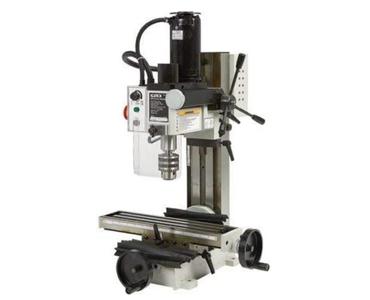
Specifications:
- Power:1/2 HP, 110v motor
- Voltage: 110 Volts
- Maximum speed: 2500 RPM
- Weight: 143 pounds
Features:
Small footprint: When using in a garage workshop having a small footprint can be of great importance and the Klutch 49657 with its small form factor can provide exactly that.
Decent motor: For the price, you are paying this mini mill is pretty powerful housing a 1/2 HP motor. It can suffice for most milling operations by hobbyists and DIY enthusiasts.
Variable speed settings: Having multiple speed modes you can fine-tune the device to meet the requirement of your specific task.
Pros:
- Decent motor
- 45-degree rotation angle
- 2500 RPM maximum speed
- Variable speed settings
- Lightweight
- Way covers
- Low power requirement
- Great for home use
Cons:
- Poor build quality
- Not suited for heavy-duty use
5. SHOP FOX M1111 Mini Milling Machine
At number five, we have another great mid-ranged mini milling machine the Shop Fox M1111 mini milling machine. It’s got a 3/4 HP motor and can speed up to 1750 RPM for clean and smooth milling.
The table is decently sized. The cast iron construction of the table and the milling machines minimizes vibration and allows you to mill with precision and stability. If you are looking for a mini milling machine for the small shop then you can definitely get the Shop Fox M1111 mini milling machine.
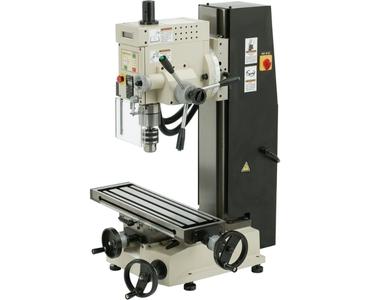
Specifications:
- Power: 3/4 HP motor
- Voltage: 110 Volts
- Maximum speed: 1750 RPM
- Weight: 416 pounds
- Dimensions: 30.5 x 31.2 x 42 inches
Features:
Decent motor: The Shop Fox mM1111 mini milling machine houses a decently powerful 3/4 HP motor. It should be more than enough for hobbyists, DIY enthusiasts, and small shop owners.
1750 RPM maximum speed: The 1750 RPM maximum speed along with variable speed settings makes this milling machine one of the best mini mill for steel.
Cast Iron construction: Cast iron development means this mini mill will produce minimum vibration while in use and provide superior accuracy and stability.
Pros:
- Decently powerful motor
- High speed
- Variable speed settings
- Cast iron construction
- Low vibration
- High accuracy and stability
- Great for small shop owners
Cons:
- Needs some tweaking out of the box
- Not suitable for professional use
Best Mini Mill for The Money (Our Top Choice)
For our top choice, we’ve chosen the Jet JMD-18. And if you’ve read through all of the reviews then you probably understand why.

A powerful motor, superb build quality, and anything else you could look for in a mini mill the Jet JMD-18 has got it. Whether you’re looking for the best mini mill for gunsmithing, steelwork, or anything else the Jet JMD-18 will be all that you will ever need.
What Is A Milling Machine?
Judging from you reading this buying guide I suppose you are new to the craft. But even if you are not, I’m going to explain what a milling machine is just in case.
A milling machine is a device used to make cuts on metal by the use of a rotating cutter having one or more cutting edges. It can be used to make flat or curved surfaces of various shapes with accuracy and fine finish. With proper attachments, it can be also used for slotting, drilling, gear cutting and to make a circular profile.
If you are a professional or hobbyist craftsman then a mini mill will allow you to design and produce small parts and pieces right in your garage.
How a Milling Machine Works?
The milling machine is used to cut, slot, and shape metal pieces. It is done by attaching a rotating cutter or other attachments with the spindle holder.
It is done by the three-axis movement most milling machines support. The table which is responsible for the X and Y-axis movement houses the metal piece to be cut. The spindle holding the cutter can be moved up and down for the Z-axis movement. All of these are done by the use of some leavers and wheels.
By manipulating the table and the spindle, the metal piece can be positioned as pleased. The cutter slowly chips away bits of metal when it is in contact with the metal piece allowing the user to cut and shape the piece as he or she wishes. This is the basics of how a milling machine works.
How To Use a Milling Machine?
Step 1: Wear Safety Goggles
When using a milling machine, you are going to have a barrage of mental dust hurdle your way. They can easily go into your eyes and nose which is probably not a good thing.
So, before you do anything grab hold of your trusty safety goggles and put them on. Obviously, you can’t work if you can’t see it.
Step 2: Attach The Proper Cutting Tool
There are all sorts of cutting and drilling attachments out there for attaching to your spindle. All of them are used to make a certain sort of cut. So, do a bit of research and find the best attachment to your work.
Check the instruction manual that comes with your milling machine to learn how you can change the cutting attachment. Also, there are plenty of YouTube videos to help you out in that regard. So, we are choosing not to elaborate.
Step 3: Fix The Vise On The Worktable
First, clean the vise and its attachment accessories. Then clean the worktable. Make sure there is no dust. Grab a sandpaper and lightly sand the table surface and the bottom of the vise. Now get some wd 40 or any other lubricant and apply a thin layer on the table and also to the bottom of the vise.
After lubrication is done place the vise on the table and also place the accessories for attaching. Grab a wrench and tighten one bolt. Now, install the indicator gauge to make sure your vise is properly place. Make necessary adjustments and then properly tighten the bolts to set the vise in place.
There are various types of vises out there. So, do some proper research before attaching your vise to the table.
Step 4: Clamp Down The Metal Piece With The Vice
Grab on to your metal piece and securely place it between the clamps of your vise. Screw the clamps shut and your metal piece will be tightly clamped in place.
Step 5: Positioning
There are all sorts of knobs and wheels to position the table and spindle. Use the two X and Y wheels on the bottom to properly position the metal piece. Then lock them into place.
Now, use the Z wheel at the side of the milling machine to properly place the cutter. There should be another smaller knob at the front for a more precise Z-axis movement. After, you have positioned the cutter lock it down.
Step 5: Start Cutting
After your metal pieces have been position start up the cutter and start cutting.
Types of Milling Machine
Altogether there are about 15 different types of milling machines. All of them can be grouped into 4 types. These are as follows –
1. Column and knee
- Plain milling machine
- Hand milling machine
- Omniversal milling machine
- Universal milling machine
- Vertical milling machine
2. Fixed bed
- Simplex
- Duplex
- Triplex
3. Planner
4. Special
- Drum milling machine
- Rotary milling machine
- Tracer milling machine
- Profile milling machine
- Planetary milling machine
- Pantograph milling machine
- NC or CNC milling machine
Now, let’s discuss briefly on each type of milling machine.
1. Column and knee
These types of milling machines are mounted on the knee-casting which is also mounter on the main columns vertical slide. These are mare for professional use in workshops.
- Plain milling machine: These milling machines are used to cut flat surfaces with the cutter axis being parallel to the surface about to be milled. The table feeding can be done either by power or hand. These are much stronger and heavier than hand milling machines.
- Hand milling machine: These are your basic type of mini mills. These are hand controlled and the cutter is held horizontally by the spindle holder. These are usually small in size and are intended to be used for small scale personal DIY projects.
- Omniversal milling machine: What is different in the case of omniversal milling machines compared to plain and hand milling machines in the additional 4th movement performed by the table. At the knee using a swivel arrangement, the table can be tilted in a vertical plane.
- Universal milling machine: Just like the omniversal milling machine the universal milling machine also has 4 movement directions. Various attachments can be used to enhance the capabilities of this milling machine.
This machine can produce spiral, bevel, spur, twist drill, milling cutter, reamer. Anything that can be done using a shaper can also be done with a universal milling machine.
- Vertical Milling machine: In this type of milling machines the spindle is positioned vertically to the table. This machine is specially designed for milling slots, flat surfaces, and grooves.
This milling machine may have the movement directions of plain or universal milling machines. But the spindle head is attached to the column which is vertical and can be spun at an angle. Some machines also offer the option to adjust the spindle up or down.
2. Fixed Bed
The fixed bed milling machines differ from column and knee type with the table being directly mounted on a fixed bed. There are no provisions for vertical or cross adjustment. The movement of the table is restricted at a right angle to the axis of the spindle. Fixed bed mills are heavy, large, and have a rigid construction.
- Simplex: One spindle head
- Duplex: Double spindle head
- Triplex: Triple spindle head
3. Planner
Also known as Plano-mill the planner type milling machines are massive machines designed for heavy-duty work. They have adjustable spindle heads in the transverse and vertical direction.
This milling machine has a cross rail that can be lowered or raised carrying the cutters. It has the saddles and the heads which are supported using rigid uprights. The machine can work on a number of work surfaces due to this arrangement of driving several cutter spindles.
4. Special
These milling machines have special designs for specific types of work. There are various sorts of special milling machines.
- Rotary milling machine: In these milling machines the table is circular in shape and it rotates to a vertical axis. This allows the cutter to rough out the workpiece and the other to finish it.
One of the advantages of the rotary milling machine is that the workpieces can be easily loaded and unloaded while the machine is running.
- Drum milling machine: This one is similar to the rotary milling machine with the difference being the table spins on a horizontal axis rather than vertical. The table of this machine is called a drum.
The cutters of this milling machine are mounted on the three or four spindle heads that rotate in a horizontal axis. They chip away metal from the workpieces. After one full cycle of the drum, the finished part is removed and new pieces are loaded.
- Tracer milling machine: Tracer milling machines are designed to make complex or irregular shapes of molds and dies. It is done by the synchronized movement of tracing elements and cutters. The oil relay system is energized by the movement of the stylus which operates the table’s main hydraulic system. This is called a servomechanism.
- Profile milling machine: Profile milling machines are given a template to duplicate. In this machine, the cutter can be adjusted horizontally and the spindle vertically. The movement of the cutter is regulated by a hardened guide pin.
The movement of the table and the cutter head follows the guide pins movement on the given template to produce the duplicate.
- Planetary milling machine: In these milling machines the workpiece remains stationary on the table. The cutter revolves around the workpiece to make a cylindrical surface on the piece either externally or internally. This machine can also be used for making external and internal threads.
- Pantograph milling machine: The pantograph milling machine uses a pantograph machine to duplicate a job. Usually, a reproduced piece tends to be smaller than the given template.
These milling machines are available in three dimensional and two-dimensional models. Three-dimensional models are used for copying contours and shapes of a workpiece. On the other hand, two-dimensional models are used to engrave designs or letters on a piece.
- NC or CNC milling machine: These are completely automated machines that use computerized automated control for milling workpieces. These are far more accurate and less time consuming then hand-operated milling machines.
A program is used to control the spindle movement in various directions and depths. Most commonly G-code is used. These days CNC or NC mills can have up to 6 axis of movement.
In the case of most CNC milling machines, the machine needs to be as big as or bigger than the workpiece. But recently much smaller three axis machines are being developed.
What to Look When Buying a Mini Mill?
Mini mills are a huge investment. Especially, if you are buying one for personal use. So, it is common sense that you should buy the affordable mini milling machine you can afford. But you need to learn what specifications and features to look for before you can choose a mini milling machine.
Power
Well, it should be obvious that when you are buying something like a mini mill the more power it offers the better. A powerful mini mill can seem too costly at first. But trust us when we say that a more powerful mini mill will cut costs enough to make the extra hundred bucks worth it.
First of all, more powerful mini milling machines will be better at heat dissipation as better components are required to support the higher power. But this also means that you can work for longer. This is because every mini mill comes with its own emergency power cut-off system that cuts off power when the heat reaches dangerous levels.
So, buying a more powerful milling machine would be a good idea if you plan on doing a number of sequential cuts back to back. Even if the power cut off doesn’t happen the components will surely be damaged as lower power mini mills are usually built with lesser quality materials.
Having a more powerful mini mill will also save you a lot more time. Being able to do a lot of cuts without worrying about overheating, emergency cut-offs or component degradation will surely boost your workflow. If you are looking to buy a mini mill for using in a workshop then buying the Jet JMD-18 you can find with the highest power would be ideal.
So, when it comes to the power, we recommend you assess what kind of work you would be doing with the mini mill, how long would you be working on it, and whether you are buying one for personal or professional use.
Size
The size of the mini mill should also be considered for choosing the best one. For casual hobbyists, a compact size might be desirable. And for the most part that should suffice. But mini mills are a device for which smaller isn’t always better.
The size of the mini mill may determine the size of the object you can work with. So, more professional users may require a larger mini mill with more versatility of use.
Spindle Clearance
You should be checking the spindle clearance of your mini mill before buying. This is the distance between the table and the spindle of the mini mill. The distance is close to the maximum height of objects that can be work on with that mini mill. So, more spindle clearance is preferable for advanced users.
Table Size
Checking the table size is also recommended while buying a mini mill. Having a bigger table will allow you to work with bigger objects. It will also allow you to clamp the smaller object more securely.
Extent of Movement
This one is an important feature that you should definitely check before buying. By extending movement we mean the distance at which the mini mill can move in X, Y, and Z planes. The more distance the mini can cover the longer cuts you will be able to do.
We do not think We need to explain why that is preferable. Especially for professional users the extra distance in all of these directions can come in pretty useful.
So, if you plan on doing a lot of complex projects that require advanced milling capabilities then make sure to check for how far the mini mill can move in all three directions.
Weight
Mini Mills can weigh hundreds of pounds depending on the model you buy. Yes, there are more portable options out there. But if you are looking to buy a professional-grade mini mill then you can throw portability out the window.
Before purchasing your mini mill make sure your workbench can support its weight. If it doesn’t you can always buy a custom-made stand from the company of your mini mill. They are specially designed to support that specific mini mill and sometimes come with a few useful features.
You should also look into buying a good shop winch if you are thinking of getting a heavy mini mill. This will provide you more versatility of use as you will be able to easily move the machine around your workplace. It is advised that you do not try to move a heavy mini mill without the necessary equipment as it may result in serious injuries.
If you don’t have the budget to invest in a shop winch then going for a lighter unit would be the ideal decision.
Vibration
When you are cutting metal and drilling holes precision is of the utmost importance. And this is achieved by a great extent when buying large and heavy mini mills that do a great job of absorbing most of the vibration.
It is when using a smaller and lighter mini mill the real struggle begins. Milling with a small mini mill will cause more vibration leading to less precision. You might end up with jagged or curved edges when making cuts. So, make sure the mini mill of your choice has good anti-vibration facilities before making your purchase.
Price
Last but not least the price is very important to consider when buying a mini mill. On one hand, not everyone has the cash to throw in hundreds to thousands of dollars. But on the other hand, buying a cheap mini mill may eventually cost you even more.
Cheap mini mill usually comes with low-quality materials and parts. So, it often that they break down and need repairs. Last time we checked there many mechanics who know their way around mini mills. So, finding a repairman can become a task of its own. The frequent repairs that are needed in the case of cheap mini mills can also cost you a hefty amount.
So, the best thing to do would be to buy a mini milling machine you can afford and hope for the best.
Safety Rules for Mini Mills
- Wear goggles before starting up the mini mill
- Makes sure no one else is near the machine besides the operator
- Make sure you keep your hands away from the cutting tool
- Always use sharp cutters
- Properly lubricate the cutting tool before use
- Securely fasten the cutting tool
- Securely fasten the workpiece and stock
- Do not leave the machine unattended while it is running
FAQs:
What Is the Best Manufacturer That Produces the Best Mini Milling Machine?
That would be Jet. Jet was founded back in 1958. They started focusing on metalworking in the 70s and since then have set an industry-standard in producing the best mini mills in the market. So, buying Jet does not only mean buying a quality product. It also means buying their years of experience in the field.
Is the Drill Press or Milling Machine the Same?
No. The drill press is used only to make vertical holes in a workpiece. Milling machines with proper attachment can also drill holes. But they can do much more if you have the right accessories.
Which Milling Machine Is the Best?
From our extensive research, we have found the Jet JMD-18 to be a favorite mini mill that you could find right now in the market. It is very powerful and provides superb build quality which makes it our top choice for the mini mill.
What Items Can I Cut With a Mini Mill?
Basically anything. From plastic to metals there are very few materials that you could not work with using a milling machine. Brass, steel, aluminum, nickel, titanium, zinc, there is nothing that a good milling machine with proper accessories cannot handle.
Which Is Better, Electric or Hand-Cranked Milling Machine?
Electric milling machines are commonly used in industries for quick automated production. Hand milling machines, on the other hand, are more popular among DIY enthusiasts, hobbyists, and small workshop owners for their low cost.
Final Thoughts
A mini milling machine is quite an expensive investment. But buying a good milling machine will greatly enhance your productivity. So, it is advised that you do not cheap out on this one and buy the Jet JMD-18 mini milling machine in our tests.
We have provided you with a list of the top-rated mini mills we could find. We have also added tons of useful information to help you decide which would be the best mini mill for you. Now, it is up to you to choose a mini milling machine.
So, we are at the end of our mini mill reviews and buying guide. Hope this helped you out. We wish you all the best. Thanks for stopping by.


